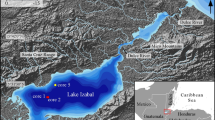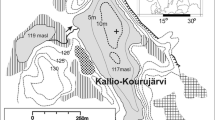Abstract
The chronology of a 184-cm-long sediment core from Onondaga Lake, New York (USA), is known with annual certainty from 2006 to the 1880s. Sediment age is known with similar precision, but less confidence, from the 1880s to the 1820s. Paired dark and light laminations are visible throughout most of the core, and are confirmed as annual varves by individual particle analysis and well-defined 137Cs age horizons. The varves can be correlated with historical impacts on the lake to within 1–2 years, stratigraphic resolution that is comparable to the best obtained from other varved lakes in which minimally disruptive sampling techniques such as freeze coring were used. Seven stratigraphic units and four sub-units were defined using visual description and the Sr/Ca profile. Onset of laminations correlates to an 1822 change in lake level. The core contains evidence of past water-quality changes, including: (1) shortened extent of seasonal calcite supersaturation in the lake during the 1800s, (2) salt industry activity during the mid-1800s, (3) calcite-precipitation (whiting) events during the 1900s, and (4) greater impact of local hydrology on lake sedimentation prior to 1900. During the late 1800s, varves were interrupted by an approximately 12-year interval of non-laminated sediment that corresponds to a time of major alteration and industrial development in the watershed. There are no apparent turbidite layers in the sediment column. Onondaga Lake owes its remarkably preserved, 200-year sediment record largely to its high rate of sediment accumulation. The rate rises from 0.1 to 0.3 cm/year just after artificial lowering of the lake water level in 1822, to about 1 cm/year during the 1900s. This study shows that anthropogenically altered lakes can contain stratigraphic records in their bottom sediments with temporal resolution comparable to the annual time steps of mechanistic water-quality models. It also demonstrates the utility of the Sr/Ca ratio profile as a sediment descriptor in carbonate-rich lake systems and provides a detailed stratigraphic basis for continued historical water-quality assessment in what used to be one of the world’s most polluted lakes.





Similar content being viewed by others
References
Allison TD, Moeller RE, Davis MB (1986) Pollen in laminated sediments provides evidence for a mid-Holocene forest pathogen outbreak. Ecology 67:1101–1105
Aspila KI, Aspila H, Agemian A, Chau SY (1976) A semi-automated method for the determination of inorganic and total phosphate in sediments. Analyst 101:187–197
Bell VJ (1998) The Onondaga New York salt works (1654–1926). Science Tribune, October. http://www.tribunes.com/tribune/sel/bell.htm. Open source
Bopp RF, Chillrud SN, Shuster EL, Simpson HJ (2006) Contaminant chronologies from Hudson River sedimentary records. In: Levinton J, Waldman J (eds) The Hudson River Estuary. Cambridge University Press, Cambridge, pp 383–397
Bradley JW (1987) Evolution of the Onondaga Iroquois: accommodating change, 1500–1655. University of Nebraska Press, Lincoln and London
Clark JVH (1849) Onondaga or reminiscences of earlier and later times, vol 2. Stoddard and Babcock, Syracuse, pp 83–107
Devan SP, Effler SW (1984) History of phosphorus loading to Onondaga Lake. J Environ Eng 110:93–109
Driscoll CT, Effler SW, Doerr SM (1994) Changes in inorganic carbon chemistry and deposition of Onondaga Lake, New York. Environ Sci Technol 28:1211–1218
Duffy MA, Perry LJ, Kearns CM, Weider LJ (2000) Paleogenetic evidence for a past invasion of Onondaga Lake, New York, by exotic Daphnia curvirostris using mtDNA from dormant eggs. Limnol Oceanogr 45:1409–1414
Effler SW (1987) The impact of a chlor-alkali plant on Onondaga Lake and adjoining systems. Water Air Soil Pollut 33:85–115
Effler SW (ed) (1996) Limnological and engineering analysis of a polluted urban lake: prelude to environmental management of Onondaga Lake. Springer, New York
Effler SW, Matthews DA (2003) Impacts of a soda ash facility on Onondaga Lake and the Seneca River, NY. Lake Reserv Manag 19:285–306
Effler SW, Peng F (2012) Light-scattering components and Secchi depth implications in Onondaga Lake, New York, USA. Fundam Appl Limnol 179:251–265
Effler SW, Whitehead KA (1996) Tributaries and Discharges. In: Effler SW (ed) Limnological and engineering analysis of a polluted urban lake: prelude to environmental management of Onondaga Lake. Springer, New York, pp 97–199
Effler SW, Rand MC, Tamayo TA (1979) The effect of heavy metals and other pollutants on the sediments of Onondaga Lake. Water Air Soil Pollut 12:117–134
Effler SW, Perkins MG, Brooks C (1986) The oxygen resources of the hypolimnion of ionically enriched Onondaga Lake, NY, U.S.A. Water Air Soil Pollut 29:93–108
Effler SW, Auer MT, Johnson N, Penn M, Rowell HC (1996a) Sediments. In: Effler SW (ed) Limnological and engineering analysis of a polluted urban lake: prelude to environmental management of Onondaga Lake. Springer-Verlag, New York, New York, pp 600–666
Effler SW, Driscoll CT, Doerr SM, Brooks CM, Auer MT, Wagner BA, Addess J, Wang W, Johnson DL, Jiao J, Dos Santos SG (1996b) Chemistry. In: Effler SW (ed) Limnological and engineering analysis of a polluted urban lake: prelude to environmental management of Onondaga Lake. Springer, New York, pp 263–383
Effler SW, O’Donnell DM, Owens CJ (2002a) America’s most polluted lake: using robotic buoys to monitor the rehabilitation of Onondaga Lake. J Urban Technol 9(2):21–44
Effler SW, O’Donnell SM, Matthews DA, Matthews CM, O’Donnell DM, Auer MT, Owens EM (2002b) Limnological and loading information and a phosphorus total maximum daily load analysis for Onondaga Lake. Lake Reserv Manag 18:87–108
Effler AJP, Gelda RK, Effler SW, Matthews DA, Field SD, Hassett JM (2008) Decreases in primary production in Onondaga Lake from reductions in point source inputs of phosphorus. Fundam Appl Limnol 172:239–253
Gelda RK, Effler SW, Matthews DA, Owens EM, Hurteau CA, Chapra SC, Auer MT, Gawde RK, Rowell HC (2012) Calibration and application of a sediment accumulation rate model—a case study. Inland Waters 2:23–36
Graber LK, Asher D, Anadaraja N, Bopp RF, Merrill K, Cullen MR, Luboga S, Trasande L (2010) Childhood lead exposure after the phase-out of leaded gasoline: an ecological study of school-age children in Kampala, Uganda. Environ Health Perspect 118:884–889
Hairston NG, Perry LJ, Bohonak AJ, Fellows MQ, Kearns CM, Engstrom DR (1999) Population biology of a failed invasion: paleolimnology of Daphnia exilis in upstate New York. Limnol Oceanogr 44:477–486
Hennigan RD (1990) America’s dirtiest lake. Clearwaters 19(4):8–23
Johnson DL, Jiao J, Dos Santos SG, Effler SW (1991) Individual particle analysis of suspended materials in Onondaga Lake, New York. Environ Sci Technol 25:736–744
Kappel WM, McPherson WS (1998) Remediation of mudboil discharges in the Tully Valley of central New York. USGS Fact Sheet FS 143-97
Lajewski CK, Mullins HT, Patterson WP, Callinan CW (2003) Historic calcite record from the Finger Lakes, New York: impact of acid rain on a buffered terrane. Geol Soc Am Bull 115:373–384
Lotter AF, Sturm M, Teranes JL, Wehrli B (1997) Varve formation since 1885 and high-resolution varve analyses in hypereutrophic Baldeggersee (Switzerland). Aquat Sci 59:304–325
Ludlam SD (1969) Fayetteville Green Lake, New York, III. The laminated sediments. Limnol Oceanogr 14:848–857
Mann ME, Bradley RS, Hughes MK (1999) Northern hemisphere temperatures during the past millennium: inferences, uncertainties, and limitations. Geophys Res Lett 26:759–762
Monetti MA, Larsen RJ (1991) Worldwide deposition of strontium-90 through 1986. Technical report EML-533, Environmental Measurements Laboratory, United States Department of Energy
Muller EH (1977) Late glacial and early postglacial environments in western New York. Ann NY Acad Sci 288:223–233
Mullins HT, Hinchey EJ (1989) Erosion and infill of New York Finger Lakes: implications for Laurentide ice sheet deglaciation. Geology 17:622–625
Munson LS (1969) Syracuse: the city that salt built. Pageant Press International, New York
Olsen PE (1985) Constraints on the formation of lacustrine microlaminated sediments. US Geol Survey Circ 946:34–35
Olsen CR, Simpson HJ, Peng T-H, Bopp RF, Trier RM (1981) Sediment mixing and accumulation rate effects on radionuclide depth profiles in Hudson Estuary sediments. J Geophys Res 86:11020–11028
Peng F, Effler SW, O’Donnell DM, Perkins MG, Weidemann AD (2007) Role of minerogenic particles in light scattering in lakes and a river in central New York. Appl Opt 46:6577–6594
Ritchie JC, McHenry JR (1990) Application of radioactive fallout Cesium-137 for measuring soil erosion and sediment accumulation rates and patterns: a review. J Environ Qual 19:215–233
Rowell HC (1996) Paleolimnology of Onondaga Lake: the history of anthropogenic impacts on water quality. Lake Reserv Manag 12:35–45
Ruttenberg KC (1992) Development of a sequential extraction method for different forms of phosphorus in marine sediments. Limnol Oceanogr 37:1460–1482
Sandman O, Lichu A, Simola H (1990) Drainage ditch erosion history as recorded in the varved sediment of a small lake in East Finland. J Paleolimnol 3:161–169
Trasande L, Cortes JE, Landrigan PJ, Abercrombie M, Bopp RF, Cifuentes E (2010) Methylmercury exposure in a subsistence fishing community in Lake Chapala, Mexico: an ecological approach. Environ Health 9:1. http://www.ehjournal.net/content/9/1/1. Open access
Wetzel RG (1983) Limnology. Saunders College Publishing, Philadelphia
Yin C, Johnson DL (1984) An individual particle analysis and budget study of Onondaga Lake sediments. Limnol Oceanogr 29:1193–1201
Zolitschka B (2007) Varved lake sediments. In: Elias SA (ed) Encyclopedia of quaternary science. Elsevier, Amsterdam, pp 3105–3114
Acknowledgments
The authors thank James Swart, Mary Jane Peachey, Steven Gladding, Ron Entringer and Chris Hoy for their help with this project. Funding was provided by Honeywell International. This is contribution 319 of the Upstate Freshwater Institute.
Author information
Authors and Affiliations
Corresponding author
Rights and permissions
About this article
Cite this article
Rowell, H.C., Bopp, R.F., Peng, F. et al. Annually laminated sediments from Onondaga Lake, New York (USA) provide a basis for high-resolution studies of lake degradation and recovery. J Paleolimnol 53, 107–121 (2015). https://doi.org/10.1007/s10933-014-9811-5
Received:
Accepted:
Published:
Issue Date:
DOI: https://doi.org/10.1007/s10933-014-9811-5




